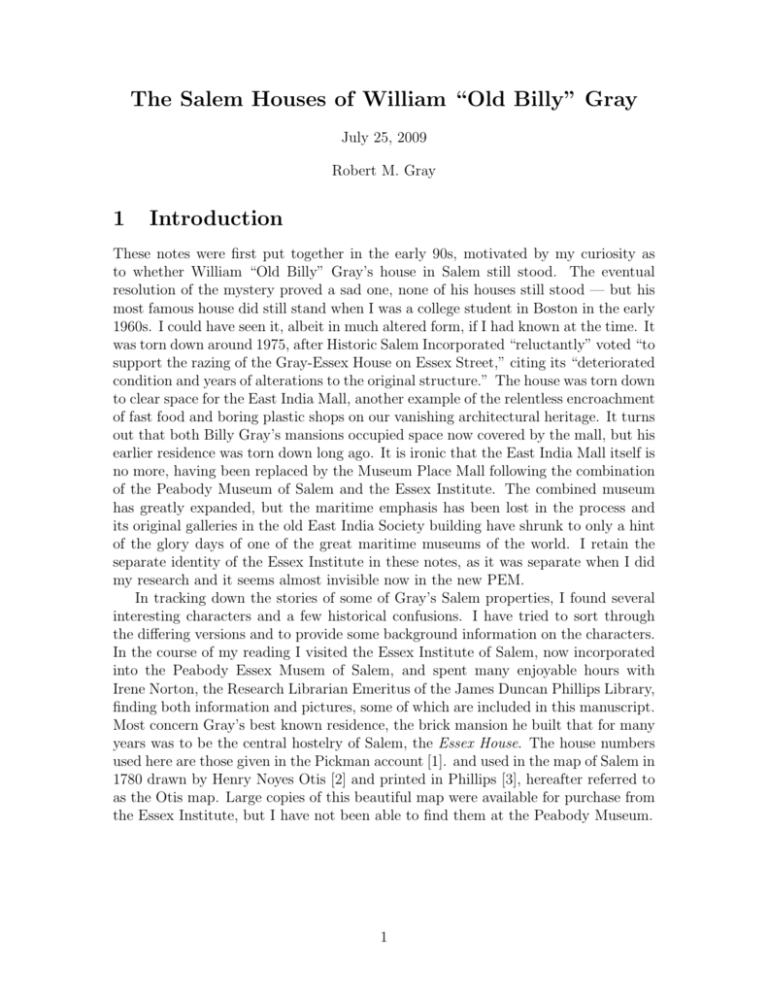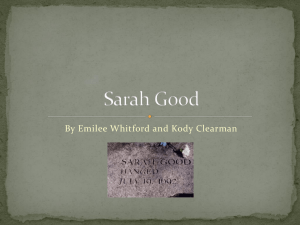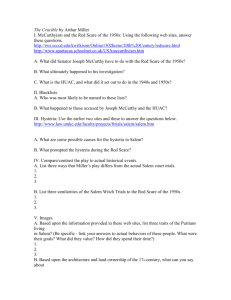The Salem Houses of William “Old Billy” Gray 1 Introduction
advertisement

The Salem Houses of William “Old Billy” Gray July 25, 2009 Robert M. Gray 1 Introduction These notes were first put together in the early 90s, motivated by my curiosity as to whether William “Old Billy” Gray’s house in Salem still stood. The eventual resolution of the mystery proved a sad one, none of his houses still stood — but his most famous house did still stand when I was a college student in Boston in the early 1960s. I could have seen it, albeit in much altered form, if I had known at the time. It was torn down around 1975, after Historic Salem Incorporated “reluctantly” voted “to support the razing of the Gray-Essex House on Essex Street,” citing its “deteriorated condition and years of alterations to the original structure.” The house was torn down to clear space for the East India Mall, another example of the relentless encroachment of fast food and boring plastic shops on our vanishing architectural heritage. It turns out that both Billy Gray’s mansions occupied space now covered by the mall, but his earlier residence was torn down long ago. It is ironic that the East India Mall itself is no more, having been replaced by the Museum Place Mall following the combination of the Peabody Museum of Salem and the Essex Institute. The combined museum has greatly expanded, but the maritime emphasis has been lost in the process and its original galleries in the old East India Society building have shrunk to only a hint of the glory days of one of the great maritime museums of the world. I retain the separate identity of the Essex Institute in these notes, as it was separate when I did my research and it seems almost invisible now in the new PEM. In tracking down the stories of some of Gray’s Salem properties, I found several interesting characters and a few historical confusions. I have tried to sort through the differing versions and to provide some background information on the characters. In the course of my reading I visited the Essex Institute of Salem, now incorporated into the Peabody Essex Musem of Salem, and spent many enjoyable hours with Irene Norton, the Research Librarian Emeritus of the James Duncan Phillips Library, finding both information and pictures, some of which are included in this manuscript. Most concern Gray’s best known residence, the brick mansion he built that for many years was to be the central hostelry of Salem, the Essex House. The house numbers used here are those given in the Pickman account [1]. and used in the map of Salem in 1780 drawn by Henry Noyes Otis [2] and printed in Phillips [3], hereafter referred to as the Otis map. Large copies of this beautiful map were available for purchase from the Essex Institute, but I have not been able to find them at the Peabody Museum. 1 2 Early Residences According to the Pickman Account, before acquiring his own house Billy Gray first lived with Samuel Gardner Esq. and afterwards with richard Derby Jr. Esq. Edward Gray mentions that Billy was an apprentice to Samuel Gardner [4]. Samuel Gardner (1712/13-1769) was the son of one of the seemingly innumerable Capt. Gardners and was one of the leading merchants of Salem. He was reputed to be the wealthiest man in town when he died [5]. According to Phillips [3], Samuel Gardner’s house was west of Town House Square on the south side of Main (Essex) St. It seems probable that Billy Gray lived with Gardner during the period of his apprenticeship, an unknown period of time between his arrival in 1762/1763 at the age of 12 or 13 and the death of Samuel Gardner in 1769. This likely was the beginning of the long period of connections between the Gray and Gardner families. Gray would later share ownership of the brigantine Ceres with Weld Gardner, the son of Samuel and Esther (Orne) Gardner. The ship was built in 1788 and registered in 1791 with Capt. Benjamin Ives as master. She was lost at sea two or three years later. Weld Gardner was a merchant in Salem and owned several ships. Weld Gardner lived in house #57 in Pickman (who misspelled his first name as Wild), a house on School Street, north of Church St. and west of the town jail. Gardner was a bachelor and in 1793 was sharing his house with Capt. Thomas Lee. Samuel Gardner’s brother John was the grandfather of Samuel Pickering Gardner, who’s two daughters Sara Russell and Elizabeth Pickering married the Gray brothers, Horace and John Chipman. Samuel Gardner’s sister elizabeth married another Captain John Gardner (a distant cousin, also descended from the founder of the family, Thomas Gardner) and their son (guess who) Captain John Gardner married Sarah, the daughter of Richard Derby, the founder of the Derby merchant house of Salem. Billy Gray’s next housemate was Richard Derby, Jr., the eldest son of Richard Derby and the brother of Elias Haskett Derby (1732–1799), the most famous of the Salem merchant kings and the first millionaire in America. This move was likely commensurate with Billy Gray’s taking a position in Richard Derby’s counting house, where he remained until setting up business for himself. Gray’s early career would be in the shadow of Elias Haskett Derby, but after Derby he was the most successful of the young merchants of his generation. By 1780 he was paying the second largest tax in town, and following Derby’s death in 1799 he became unquestionably the wealthiest and most influential merchant in Salem. Richard Derby, Jr., was reknowned as a sea captain while Elias ran the business following the death of Richard Sr. in 1783. Richard Jr. was a member of the Provincial Congress in 1774 and 1775. He added to his fame by relaying a suggestion of Congress to his father to send a fast ship to England following the battle of Lexington to present the American side of the story to the Lord Mayor of London before the dispatches of General Gage could arrive. Richard Sr.’s son Capt. John Derby commanded the successful adventure. [6, 7] Richard Jr. lived in a small house near his father’s house, which was on the easterly corner of Derby and Herbert Streets. The house of Richard Sr. was later called the 2 Miles Ward House. 3 The Court Street House House # 80 in the Pickman Account. [1]. The property bearing William Gray’s name on the Otis 1780 map is located on the Highway to Marblehead, a continuation of School St. At the time it was called Otis map of Salem around 1780 Location of Billy Gray houses: #80, #29, #36 Court St. because the original Court House was on the street. The property was owned by Samuel Baron Esq., who sold it to Miles Ward, Jr., who built a house on it. Barton did not like the property because of a slaughterhouse in front of it, but he retained nearby property on which he built a house for his son. Ward later sold the property to Nathaniel Sparhawk, a grandson of Sir William Pepperell. Sparhawk sold the property to Billy Gray, who owned it in 1780. Gray later sold the property to a Capt. Nichols. 3 4 The Mansions Both of Billy Gray’s mansions were on what is now Essex Street. From 1694 through 1805 it was called ye Main Street and the name was changed in 1805, when Billy lived in his second mansion. Before 1694 the street had been called the street from ye meeting house to ye harbor (1653), the street that comes straight from the meeting house (1659), and ye street that goeth from ye meeting house to the training place (1671). The street was first paved in 1792, partly by the Town and partly by subscriptions, the town contributing $1000 and the residents contributing a total of $600. Both of Billy Gray’s mansions were built on property owned for many years by the Browne family of Salem. Their story is mixed in with that of both houses. The First Essex St. Mansion House #29 in the Pickman Account. The house was first built by the Hon. William Browne Esq. (b. 1639) in 1698 to replace his previous house, which had been lost in the great fire. He died quite wealthy in 1716 at the age of 76, leaving the house to his grandson William, the husband of Governor Burnet’s daughter, who died at age 54 in 1763. The house then passed to his son, William Burnett Browne. Here a variety of stories exist. According to Perley [8], when William Burnett Browne left Salem for Virginia, he conveyed the house and lot to Catherine Sargent for four hundred pounds. As Perley’s source is the Essex Registry of deeds, I will follow his line first (although the other stories are more colorful). Catherine Sargent sold the estate for three hundred pounds to Paul Dudley Sargent on 16 September 1780. The property is listed as belonging to Paul Dudley Sargent on the Otis map of 1780. Mr. Sargent sold the property and its house an barn to Jesse Fearson, a Salem merchant, on 12 November 1781 for two thousand pounds. Mr. Fearson conveyed the same estate to Billy Gray on 17 September 1783. Other versions state that William Burnett Browne sold the house to his cousin, Col. William Browne [6]. This Col. Browne is one of the most interesting people to arise in connection with Billy Gray’s houses. He was a tory loyalist who fled Salem in 1774 to take refuge in Boston before leaving for England in 1776. The year is interesting because in it took place one of the confrontations between colonists and British soldiers that occurred before the battle of Lexington two years later, but which did not explode into gunfire. General Gage had sent troops to break up the Salem town meeting where seditious behavior was feared. First, however, Gage took time to be lavishly entertained by Browne. At the party, however, Gage was distracted by clever townsfolk and got so upset that he did not act in time to prevent the meeting from concluding its business. In the meantime, troops had been called up and bloodshed feared, but none occurred. The resulting anti-British feeling was so strong, howoever, that Browne and his family left all of their possessions and fled to Boston. Browne had been a pillar of the community, serving as a representative, superior court judge, and colonel of the regiment. He followed a long line of five generations of distinguished citizens of Salem. He had been born in 1737 and he graduated from 4 Harvard in 1755. He owned a large estate, including what is now Derby Square. As a result of his departure, all of his property in Salem was confiscated in 1784. He lost his mansion, gardens, wharfs, and stores as well as anothyer house and adjoining land in Salem. He was the only resident of Salem to lose property by confiscation. According to one story, this house was one of those confiscated and William Gray bought it as an absentee estate at public vendue following the revolution [9, 10]. This story seems unlikely since Col. William Browne in fact had another mansion in Salem (#4 in Pickman) which was indeed confiscated and which was bought by Elias Haskett Derby (who was related to Browne) after Browne fled with his half-brother, John Sargent. The remaining confiscated property does not fit the description of the house. Another, more probable, version states that Col. William Browne’s mother, who was then the wife of Col. Sargent, received the house in payment of a debt due her by her son and subsequently sold it to Billy Gray on 17 September 1783. [1] This story is consistent with Perley’s since the sale of the house by William Burnett Browne to Mrs. Sargent could have been arranged (and paid for ?) by Col. William Browne. Col. William Browne was later (1781–1788) Governor of Bermuda and he died in London in 1802. When Gray bought the house, it was a large and stately mansion standing eighteen feet back from the street. [9] He had the house beautified and lived in it until 1800, when he moved to his second mansion at 176 Essex St. Billy Gray sold the house to Union Marine Insurance for $13,500. On 25 June 1805 it became the Sun Tavern with Benjamin Webb as landlord (more later on the Sun Tavern). The original Sun Tavern sign from this location is supposed to be in the possession of the Danvers Historical Society [9]. On 15 November the house was sold to Mr. William Manning of Salem. He tore it down and had William Roberts construct the Bowker Building there in 1830, one of the “malls” of the time (later the location of the first Filene’s store). The Bowker Block was in turn torn down for construction of the East India Mall in the 1970s. The Rogers store occupied the site when I visited in the early 90s, selling fancy clothes. Just to the east of this house, opposite the head of Liberty St., stood the house of Daniel Ropes, which he inherited from his father Joseph Ropes. To the west stood another of the Browne’s family houses, which was occupied by Colonel Newhall in 1780. 4.1 176 Essex St. House #36 in the Pickman Account. Billy Gray’s best known house during his life in Salem was undoubtedly the mansion he constructed at 176 Essex St., a building famous of years as the Essex House and which lasted, in much altered form, until torn down in the 1970s to make way for the construction of the East India Mall. In addition to the Essex House, the property housed many famous inns and taverns in its time. Immediately to the east in 1780 stood the house of Same Gale, the barber. To the west stood a house occupied in 1780 by Capt. Nathanial West, Elias Haskett Derby’s son-in-law. The West house 5 176 Essex St., Salem, MA. About 1800 Taken from a drawing in E.I. Collection. Courtesy, Essex Institute, Salem, Mass. 6 was built by John Turner Esq in 1748 and then sold to Judge Andrew Oliver, who sold it to West. The house became a public house in 1833 on the occasion of a visit by President Andrew Jackson and it was known as the Mansion-House until it was destroyed by fire around 1857. Before Turner built the house, the property had an illustrious history of taverns. For a long time it was the location of the Ship Tavern, the most noted in Salem during the seventeenth century. John Gedney was the proprietor before 1692, followed by John Stacey, Francis Ellis, and Henry Sharpe. The vicinity had a reputation for public houses from about 1675 on. The Billy Gray property and the site immediately to the west were the locations of the above taverns as well as the King’s Arm Tavern (which became the Sun Tavern as the king’s popularity faded), Pratt’s Tavern (before 1730, it was supposed to have been the most famous tavern ever in Salem; it was torn down in 1740), Goodhue’s Tavern, Robinson’s Tavern, Webb’s Tavern, the Essex Coffee House, the Lafayette Coffee House, and, finally, the Essex House. Before Pratt occupied the tavern, the property was owned by the Curwens, of witchcraft hysteria fame. The first known owner of the property was Peter Palfry, one of the original “old planters.” His homestead occupied the area between the West block, nearly opposite Market (Central) St., and the head of St. Peter St. He owned the property from before 1651 through 1664, when he sold it to William Browne Esq. William Browne built a mansion on the grounds in 1652 which he occupied until his death in 1667 at age 79. This house was thereafter called the Browne mansion-house, leading to some confusion with house #29 mentioned earlier. Both of the Billy Gray mansions occupied sites on which mansions built by a William Browne had stood and on which a Sun Tavern stood! This led to considerable confusion in disentangling the history of the two houses. The house was then occupied by William’s son Benjamin Browne Esq., until his death at age 60 in 1708. As he had no children, he left the house to his nephew, John Browne Esq., who died in 1719 at age 46 and who left the house to his son, another Benjamin Brown Esq., who lived there until his death in 1750 at age 43. This Benjamin Browne represented the town for many years in the General Court and was Lieutenant Colonel of the Regiment. The house gained some reknown when a “vast sum” of English shillings was found in one of the chimneys of the house during Col. Browne’s wedding in 1730. [6, 1]. The money was assumed to have been hidden during the Dutch wars. After Colonel Browne’s death, his children inherited the house and his widow lived there until she remarried in 1751 and moved to Boston. An interesting sidelight on the Browne mansion is that apparently some of Hawthorne’s descriptions in the House of the Seven Gables came from this house rather than from the better known Turner house now often called the House of the Seven Gables. In particular, a rough ornament beneath the eaves was taken from the Browne mansion before it was razed by Billy Gray and was likely seen by Hawthorne in the Essex Institute [12]. After the departure of the widow Browne, the house was occupied in succession by the Rev. John Sparhawk until his death in 1755 at age 43, Richard Lechmere Esq., Andrew Oliver Esq., John Turner Esq., and then William Goodhue, tavern-keeper. 7 Lechmere was the Salem Collector of Customs in 1759 and a nephew of Nicholas, Lord Lechmere, of the reign of George I of England. He was reputedly one of the best bred men in Salem. Goodhue was occupying the building by about 1770 [6] and he purchased the house on 29 November 1780. It was called the King’s Arm Tavern at the time, but the name was changed to the Sun Tavern at the beginning of the revolution in 1776. The King’s Arm Tavern was notorious in 1768 as a meeting place for merchants and traders discussing a boycott of all imported British goods save coal and salt. [6] Goodhue owned the house until 1796, but he regularly leased it to others, notably Samuel Robinson, Capt. Benjamin Web, and then Capt. Webb’s son Jonathan Webb. Jonathan Webb also owned a tavern on School St. in 1780 (House #55 in the Pickman Account [1]). Goodhue and Robinson had also managed public houses on the South side of Essex Street to the east of the Billy Gray house, in a house built by Mr. Hirst in 1700 and subsequently owned by Major Walter Price, Ichabod Plaisted Esq., and a Scotsman named Somerville, who first kept a public house at this address. Hence it is difficult to know if references just before 1770 to Goodhue’s or Robinson’s Tavern are to this house or the Billy Gray house. During much of this time it was called the Sun Tavern, but it was also known as Goodhue’s Tavern and Webb’s Tavern and the names often crop up in Salem history and guide books as local gathering places. The 1793 Pickman Account states that the tavern, then run by Webb, was the most noted in town. Phillips [3] describes Webb’s Tavern as the most famous tavern in town in 1783. Goodhue’s Tavern is noted on the Otis map. At this time the property was on the north side of Ye Main Street, between Ingall’s Land and St. Peter St. In 1796 Goodhue sold the property to Jeremiah Allen of Boston, who in the same year sold it to Billy Gray. According to the Pickman Account, the house was owned by the Browne children until 1788, when the last, John Browne, died leaving it to his widow, who was an Allen. When Billy Gray purchased the property, the house was called the Sun Tavern and it was roughly opposite the head of what was then Market Street and is now Central Street, close to the Peabody Museum of Salem. According to [10], Benjamin Webb was landlord when Billy Gray bought the house and it was Webb that moved into the house Gray had just vacated and promptly hoisted the Sun Tavern sign there. It is ironic that Billy Gray effectively traded houses with the Sun Tavern. The new house was somewhat farther in from the street and farther eastward than its predecessor. He moved into his new house in 1800 and remained there until he left Salem in 1809. After Gray left, virtually driven out 176 Essex St., Salem, Mass. of town because of his Republican sentigift of Mrs. Mary C. Hart ments in support of the Federal governCourtesy of the Essex Institute ment, President Jefferson, and the Em8 bargo Act of 1808, his house was enlarged and altered and became the Essex Coffee House sometime before 1814. His stable was converted into the eastern wing of the building. The garden was originally located near the corner of Essex and St. Peter St. The house itslef was located between Market and Liberty Streets. The establishment’s name was changed to the Lafayette Coffee House in 1824 following Lafayette’s last visit to Salem. During this period there were a fine old fireplace and a mantel in the office and a pictorial paper with scenes of the French Revolution covering the walls of the parlor. The house was also called simply the Lafayette House for a while. During 1842–1877 the inn was called the Essex House. 5 Gray’s Wharf Billy Gray’s counting house and warehouse were located at 311 Derby St., which then sat on the shore and had a wharf extending into the South River. The wharf seems to be the same as that called Faben’s wharf, which was at the end of Fish St., but I have not been able to confirm this. The warehouse was later occupied by J.P. Langmain and Sons. 9 Essex House (William Gray House) 176 Essex St., Salem, MA. Essex Institute Negative Number 18941 Copied from the glass neg. 9310 in the library collection. Courtesy, Essex Institute, Salem, Mass 10 Essex House, 176 Essex St., Salem, MA. Essex Institute Negative Number 18943 Copied from a photo in the library collection. Courtesy, Essex Institute, Salem, Mass 11 12 References [1] George B. Loring, “Some account of houses and other buildings in Salem, from a manuscript of the late Col. Benj. Pickman,” Historical Collections of the Essex Institute, vol. VI, pp. 98–109, June 1864. [2] Map of Salem about 1780. Based on the researches of Sidney Perley and the accounts of Col. Benjamin Pickman and Benjamin J.F. Browne with additional information assembled by James Duncan Phillips and Henry Noyes Otis. Drawn by Henry Noyes Otis. 1937. Published in Phillips [3]. [3] James Duncan Phillips, Salem in the Eighteenth Century, The Riverside Press, Houghton Mifflin Co., Boston 1937. [4] Edward Gray, William Gray of Salem, Merchant, Riverside Press, Houghton Mifflin, Cambridge, 1914. [5] Frank Augustus Gardner, Gardner Memorial, Newcomb and Gauss, Salem, Mass, 1933. [6] C.H. Webber and W.S. Nevins, Old Naumkeag, A.A. Smith & Co., Salem, Mass., 1877. [7] Robert E. Peabody, Merchant Adventurers of Old Salem, Riverside Press, Houghton Mifflin, Cambridge, 1912. [8] Sidney Perley, “Salem in 1700, No. 16,”The Essex Antiquarian, Vol. VIII, 1904 pp. 113–116. [9] Visitors Guide Salem, Essex Institute, Salem, Mass. 1895. [10] Essex Institute Historical Collections, Vol. IV, p,. 80. [11] Salem and the Indies, Riverside Press, Houghton Mifflin, Boston, 1947. [12] Frank Cousins and Phil M. Riley, The Colonial Architecture of Salem, Little Brown & Co., 1919. 13





